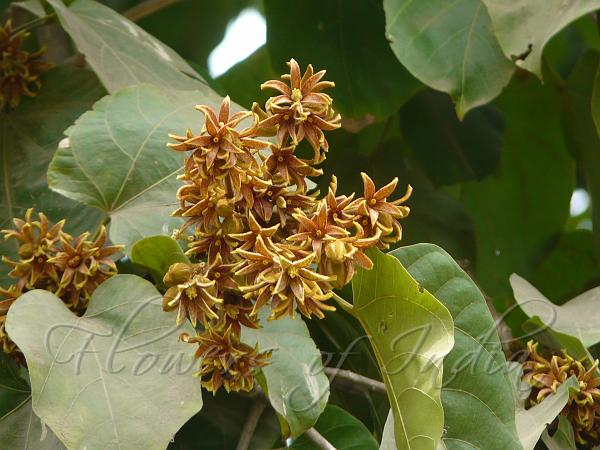|
| Buddha Coconut |
|

|

| File size | 2453475 |
| Original date | 3/15/09 12:11 PM |
| Resolution | 2560 x 1920 |
| Flash | Flash did not fire, auto |
| Focal length | 63.3mm |
| Exposure time | 1/100s |
| Aperture | 3.6 |
| Focus Distance | |
| Metering Mode | Multi-segment |
| Camera make | Panasonic |
| Camera model | DMC-FZ18 |
| Sensor type | OneChipColorArea |
|
|
|
|
Photo: |
Botanical name: Pterygota alata Family: Sterculiaceae (Cacao family)
Synonyms: Sterculia alata
Synonyms: Sterculia alata
Buddha Coconut is a tall tree, which gets is name from its coconut like
fruit. Leaves are carried on 3-10 cm long stalks, crowded towards the ends
of branches. Leaves are blade broadly ovate-heartshaped, 10-25 cm long,
7-15 cm broad, wavy, smooth, pointed or tapering. Flowers are borne in
small, few-flowered racemes. Flowers are 1-1.5 cm across, on 2-3 mm long
stalks. Flowers have no petals, sepals are 5, nearly free, linear-lance-
shaped or elliptic, 1.2-1.5 cm long, 3-4 mm broad, fleshy, densely
ferruginous pubescent outside, sparsely velvet-hairy and purple with red
streaks within. Anthers in male flowers are united into 1-2 mm broad head
on 4-6 mm long staminal column. In bisexual flowers sessile anthers are
arranged in clusters of 4 or 5 in the sinuses formed by the carpels.
Carpels are 5;ovaries sessile, 2-3 mm long, pubescent; style recurved.
Fruit is large, woody, 7-12 cm in diameter, obliquely round. Seeds are
about 40 per follicle, oblong, compressed, in 2 rows, winged. In India,
seeds are eaten, and plant used medicinally. Buddha Coconut is native to
India, and found variously in S.E. Asia.
| Identification credit: Navendu Pāgé | Photographed in Lodhi Garden, Delhi & Jijamata Udyan, Mumbai. |
• Is this flower misidentified? If yes,